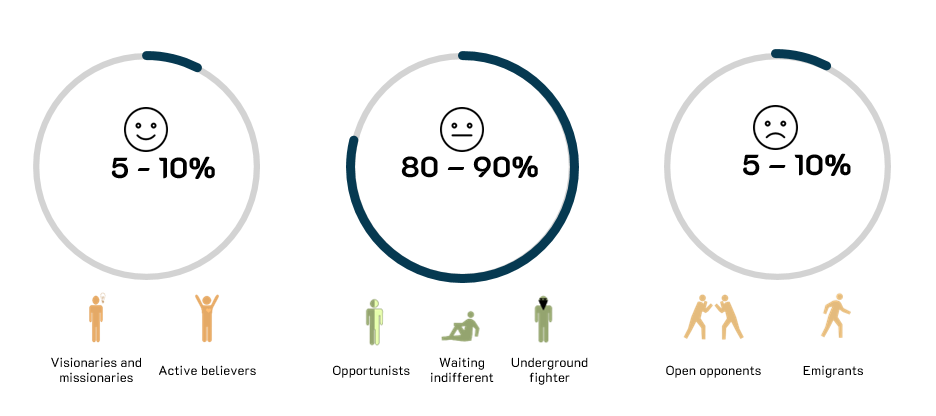90% of decisions are made unconsciously.
A human being makes about 20,000 decisionsevery day, most of them unconsciously.1 Dealing with each one individually would consume too many time and cognitive resources, so information processing is abbreviated in many cases. In order to still give impetus to behavior, humans use heuristics as a guide. This involves making presumptive inferences from situations with limited knowledge and time.
Frequently, the representative heuristic is applied. This judges the probability with which an object belongs to a category according to the similarity it has with the category. For example, a car with a sports car design is directly associated with high fuel consumption.
For effective change management, visual, haptic and acoustic coherence is thus recommended when introducing processes.
Man is a creature of habit.
Changes mean deviations from the original state. The status quo bias2 describes the emotional preference for the current state of things. Any divergence from this is perceived as a loss. It is obvious that this psychological effect has a significant influence on change processes. An essential task of change management is therefore to formulate change as progress and benefit and to work out the questioning "what is in it for me" for each target group.
It's all a matter of perspective.
Framing is an effective method to cope with the status quo bias. This allows the different presentation of the same scenario to elicit different reactions. When a message is framed positively, people also tend to respond more kindly.
For example: "The annual target can still be achieved if one additional working hour per week and employee is invested!" vs. "The annual target will be missed if one more working hour per employee is not invested each week!"
Which formulation of the same scenario would motivate you more to work extra hours and achieve the goal?
From the underground to the active believer.
In a change process, the people involved can be roughly divided into three groups. About 5 - 10 % are visionaries and missionaries, who actively shape the change. The same proportion are open opponents and emigrants who eagerly resist. Both parties strive for the remaining neutral-minded 80%, such as opportunists and wait-and-see indifferents who fear the consequences of leaving the original state. In the course of the change process, more and more neutral participants can be convinced, so that at least one in four joins the alliance of the willing if the change is successful.

Said - Done?
In addition to take into account the various factors influencing human behavior, target group-specific change communication is also an important factor.
It can take a while for a message to be understood and acted upon by the addressee. People have to be adequately confronted with a message 7 times before they integrate it into their everyday life in a sustainable way.3
Would you like to make your change project successful?
Contact us. We are looking forward to exchange ideas with you.
Your Organisational Change Team at Munich Consulting Group.
1 Pöppel, 2008
2 Kahnemann, Knetsch & Thaler, 1991
3 Lorenz, 1971

